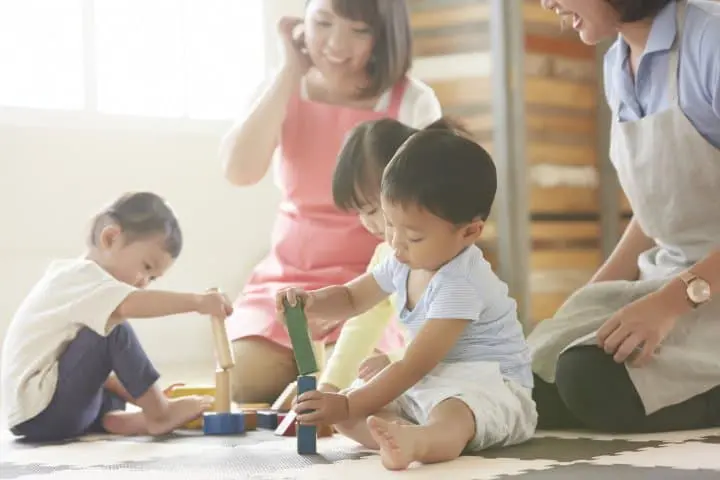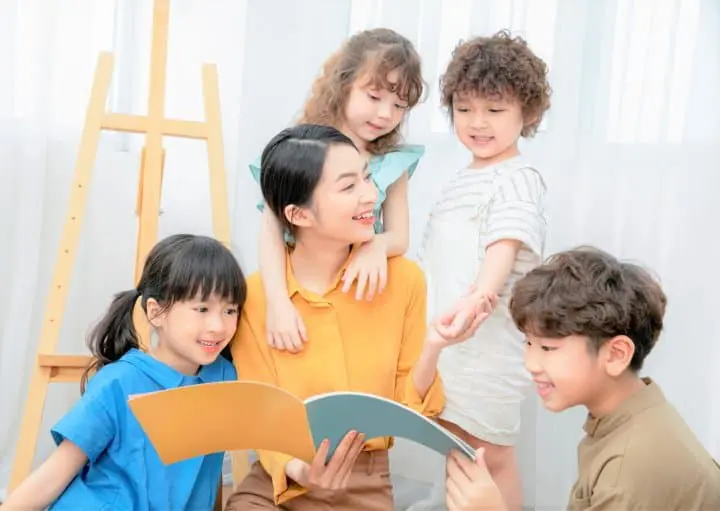Daycare Or Preschool? Guide To Hours, Fees, And More

Early education starts with daycares and preschools. Learn about the differences between the two facilities including programs, target age, operating hours, and fees. Moreover, what is the meaning of Early Childhood Education and Care (ECEC)? Find out this and more in the article below!
Daycares and Preschools

Once children enter the picture, many moms and dads worry about juggling work and parenting. They also have to think about their child's education.
In these instances, you can depend on daycares and preschools. These facilities will look after your children before they're of age to enter elementary school (*).
A daycare is a child welfare facility for households where both parents are either working full-time or caring for an elderly relative. On the other hand, a preschool (or kindergarten) is an educational institution.
The operating hours, long holidays, and other similar services will differ as the objectives of both facilities are different. In this article, we'll introduce the features of daycares, preschools, as well as Centers for Early Childhood Education and Care (ECEC): a combination of the best of both systems.
*1: In Japan, children attend elementary school and begin compulsory education in the April after their sixth birthday.
The Main Differences Between Daycare and Preschool
| Facility | Daycare | Preschool |
| Objective | Child care | Education |
| Target Age | Infant (0-year-old) until elementary school age | 3-years-old until elementary school age |
| Operating Hours | Generally 8 hours | Standard 4 hours |
| Long Holidays | None | Summer vacation, spring vacation, etc. |
| Lunch Service | Included | Each institution will vary (parents may be required to pack a lunchbox) |
| Cost | Determined by the municipality based on household income. Monthly average is around 20,000 yen. | The cost of private school is determined by the institution while public school is determined by the local government. Monthly average for private school is 40,000 yen and public is 18,000 yen. |
*Made in reference to the Ministry of Education, Culture, Sports, Science, and Technology (MEXT): “On the so-called centralization of preschools and daycare centers” (Japanese)
Now, let’s take a look at the features of daycares and preschools!
Shop online for baby and kids products: Amazon, Akachan Honpo, and Combi (Japanese)
Daycare: Leave Your Children Supervised Until 18:00

A daycare will look after your child when parents are either working full-time, are ill, or caring for an elderly relative.
Generally, the facility can look after your child from 7:00 to 18:00. This way, parents can pick up their children on the way home from work.
During daycare, kids are served nutritionally balanced food and snacks, take an afternoon nap, and are monitored during playtime.
The enrollment process is determined by a score based on your family's work circumstances. Families unable to provide child care at home will be prioritized.
Recently, there has been a waiting list problem in areas with huge populations, such as Tokyo, due to the number of applications exceeding the enrollment limit. If you're worried, ask the daycare department in your municipality about the current status of the waiting list.
Preschool: Placing an Emphasis on Education!

Preschools place more emphasis on education compared to daycares. However, the educational curriculum that each institution focuses on will vary.
Preschools are typically placed into two categories. "Study-type" preschools focus on reading and writing hiragana (the Japanese writing system), English education, and discipline. "All-play" preschools focus on playful activities, such as growing vegetables and dancing.
However, both study and all-play schools will hold events like sports days and excursions. It's the perfect place for children to learn social skills.
Preschool hours are usually around 9:00 to 14:00. If you require after-hours care, it will cost an additional fee. Keep in mind that daycares always provide lunch, but preschools may require you to pack a bento (lunch box) for your child.
Multilingual Support at Daycares and Preschools

Unfortunately, many daycares and preschools in Japan are unable to provide multilingual support. There are some facilities, however, that use translation tools for communication or employ foreign teachers.
The information on types of child-care support available for non-Japanese citizens is published in various languages on the Kanagawa International Foundation’s official website. Local governments are also establishing consulting services for non-Japanese citizens in cities such as Tokyo and Osaka. Feel free to use the article below as an additional reference.
The Best of Both Systems! What is ECEC?

Centers for Early Childhood Education and Care (ECEC) offer both preschool and daycare services in one facility.
Since its establishment in 2006, several daycares and preschools have transitioned into ECEC certified. As of 2018, that number has expanded to over 7,000.
The merit of an ECEC is not needing to change facilities when moving your child from a daycare center to preschool and vice-versa. Allowing your child to continue attending a place they've adjusted to relieves the burden on parents and kids.
ECEC is split into three types: Type 1 Certification corresponds to a traditional preschool, Type 2 Certification (over 3-years-old) and Type 3 Certification (under 3-years-old) corresponds to a traditional daycare. The maximum fee will vary on which certification type your child is enrolled.
| Type 1 Certification | Type 2 Certification | Type 3 Certification | |
| Eligibility | Children over the age of 3 from families that do not need child care from facilities such as daycares. | Children over the age of 3 from families that require child care from facilities such as daycares. | Children under the age of 3 that require child care from facilities such as daycares. |
| School Hours | Preschool hours apply | Daycare hours apply | Daycare hours apply |
| Monthly Maximum Fee | 25,700 yen or less | 101,000 yen or less | 104,000 yen or less |
Some Precautions Before Enrolling Your Child

What we have explained so far are only the basic features of daycares, preschools, and ECEC.
All three child-care facilities will provide different services. Some daycares may emphasize education while other preschools may offer extended hours. Therefore, you should visit and confirm the details with your desired facility at least once beforehand.
Additionally, if you wish to enroll your child in a daycare, preschool, or ECEC in April, applications are sometimes submitted in November the previous year. Taking this into account, we suggest researching facilities at least a year prior to your desired enrollment period.
What to Prepare Before Entering Elementary School

Families with children of foreign nationalities will receive a guidance letter before elementary school begins. Be sure to apply for schools following the instructions in the guidance letter.
Other Useful Child-Care Services
If your child’s daycare enrollment hasn’t been confirmed, you can use “ichiji hoiku” (一時保育): a temporary child-care system. Parents can temporarily leave their children at daycare due to urgent business or parental burnout.
There are other reliable services and facilities, including your municipality’s family daycare provider, babysitters, family support, and child-care facilities for kids recovering from an illness. The cost and details will differ with each local government and facility, so please contact them for more information.
Shop online for baby and kids products: Amazon, Akachan Honpo, and Combi (Japanese)
All photos by Pixta





































![[Yamanashi/ Hokuto City] 4 Hot New Spots Opening in 2026](https://resources.matcha-jp.com/resize/720x2000/2025/12/12-252747.webp)



